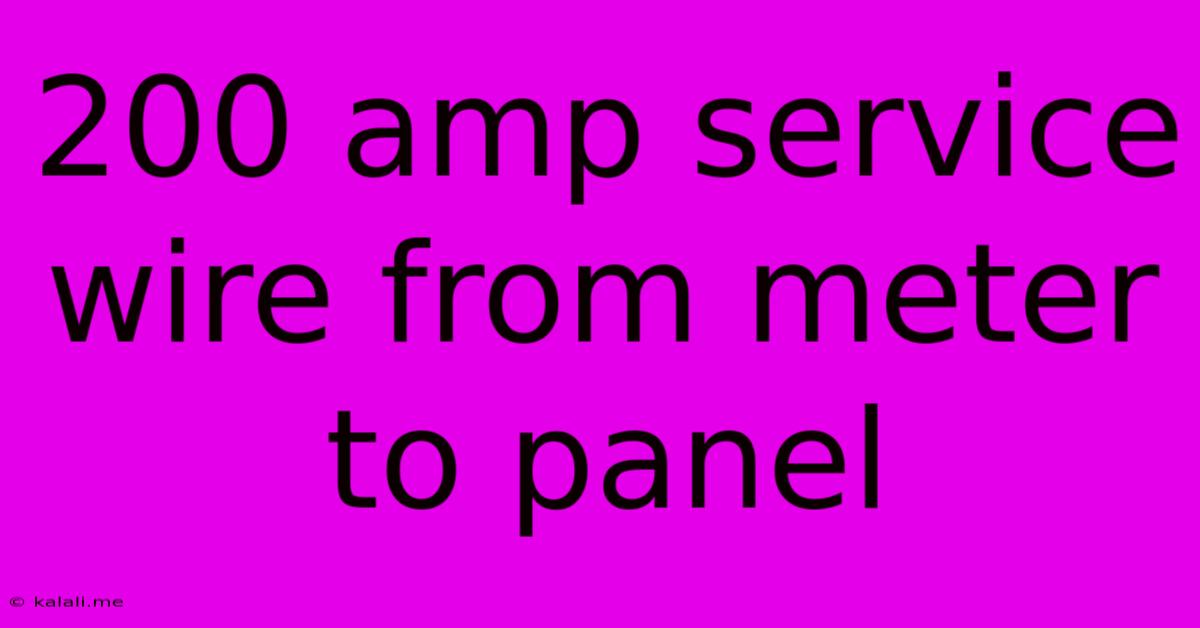200 Amp Service Wire From Meter To Panel
Kalali
May 31, 2025 · 3 min read

Table of Contents
200 Amp Service Wire: From Meter to Panel
Choosing the right wire for a 200-amp service is crucial for safety and optimal electrical performance. This guide details the process of selecting and installing the appropriate wire from the meter to the electrical panel, covering essential considerations like wire gauge, material, conduit type, and safety practices. Understanding these factors ensures a reliable and code-compliant electrical system.
Understanding the Requirements for a 200-Amp Service
A 200-amp service provides a significant amount of power, suitable for larger homes or those with high energy demands, such as electric heating or multiple high-wattage appliances. Determining the correct wire gauge is paramount. Incorrect sizing can lead to overheating, voltage drop, and potential fire hazards. Local electrical codes will dictate specific requirements, so consulting with a qualified electrician is strongly recommended before starting any electrical work.
Key Factors in Wire Selection
Several factors influence the choice of wire for a 200-amp service:
-
Ampacity: This refers to the maximum current a wire can safely carry. For a 200-amp service, the wire must have an ampacity rating at or above 200 amps.
-
Wire Gauge: The gauge indicates the wire's diameter, with lower numbers representing thicker wires capable of carrying more current. A 200-amp service typically uses a relatively thick gauge wire, often #2/0 aluminum or #4/0 copper. The specific gauge will depend on the length of the run and other factors, as detailed below.
-
Wire Material: Aluminum and copper are the most common materials. Aluminum is lighter and less expensive, but requires special connectors and installation techniques. Copper is more conductive, more flexible, and generally preferred for shorter runs.
-
Conduit Type: The wire must be run within a protective conduit, such as PVC (polyvinyl chloride) or metal conduit. The conduit protects the wiring from damage and ensures proper grounding. Local codes often specify conduit type and installation requirements.
-
Length of Run: The distance between the meter and the panel significantly impacts wire gauge selection. Longer runs necessitate a thicker gauge wire to compensate for voltage drop. Voltage drop is the reduction in voltage along the length of the wire, which can affect the performance of appliances and equipment.
Calculating Voltage Drop and Wire Sizing
Accurate voltage drop calculation is essential. Several online calculators and software programs can assist in determining the appropriate wire size based on the service amperage, distance, and voltage. These tools consider factors like the wire material and temperature. Remember that these calculators provide estimations, and professional consultation is crucial for compliance.
Installation Procedures: A Step-by-Step Overview
While this section provides a general overview, professional electrical installation is strongly advised. Improper installation can lead to serious safety hazards.
-
Planning and Preparation: Carefully plan the wire route, ensuring proper grounding and avoiding potential hazards. Obtain the necessary permits.
-
Conduit Installation: Install the conduit, securely fastening it to the structure. Maintain proper bends and ensure a smooth pathway for the wire.
-
Wire Pulling: Carefully pull the wire through the conduit, avoiding damage to the insulation.
-
Connections: Make secure connections at the meter and the panel using appropriate connectors and following manufacturer instructions.
-
Grounding: Ensure proper grounding according to local electrical codes. This is vital for safety.
-
Inspection: After completion, have a qualified electrician inspect the installation to ensure it meets all safety codes and regulations.
Choosing the Right Materials and Tools
Selecting high-quality materials is vital. Use wire and connectors rated for the 200-amp service. Appropriate tools, including wire strippers, crimpers, and conduit benders, are necessary for a safe and efficient installation.
Safety Precautions
Always follow safety precautions when working with electricity. Turn off the power before working on any electrical circuits. Wear appropriate safety gear, including gloves and eye protection. If unsure about any aspect of the installation, consult a qualified electrician.
This comprehensive guide provides a detailed overview of installing a 200-amp service wire. However, always prioritize safety and consult with a licensed electrician for professional installation and adherence to all local codes and regulations. The information here is for educational purposes only and does not substitute professional electrical advice.
Latest Posts
Latest Posts
-
Blood Moon Scriptures In The Bible
Jun 01, 2025
-
What Does Trimming The Tree Mean
Jun 01, 2025
-
How To Delete Usb Flash Drive
Jun 01, 2025
-
Threw Me For A Loop Meaning
Jun 01, 2025
-
How To Save Gta 5 Game
Jun 01, 2025
Related Post
Thank you for visiting our website which covers about 200 Amp Service Wire From Meter To Panel . We hope the information provided has been useful to you. Feel free to contact us if you have any questions or need further assistance. See you next time and don't miss to bookmark.